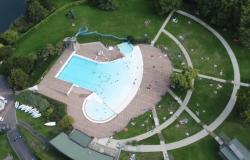By
Olivier Bacquet
Published on
June 5, 2024 at 6:12 a.m.
See my news
Follow Le Journal d’Abbeville
Thursday May 30, 20244:10 p.m. In a pasture located high up on the L’Étoile road, at the exit of Long (Somme), the layer of grass is suddenly pierced by a large metal pipe pointing towards the sky.
And a broad smile forms on the faces of those who attend the show.
More than 500 meters of “crossing”
This pipe had been driven into the ground a few days earlier… and more than 500 meters away. At the entrance to the municipal campsite to be precise, near the hydroelectric power station.
Or on the other side of the Somme, and on the other side of the Château de Long park.
Between the entry point and the exit point, no apparent sign. But 517 meters of pipes were successfully passed under the river and under the park.
And it is the most complex stage of a very long-term file which has just been completed: that of collective sanitation.
Pass under the Somme and the park without making trenches
“We have been talking about it for more than twenty years,” breathes Mayor Jean-Marie Pecquet, who does not hide his relief at seeing this tip come out, only 50 centimeters from the planned point“after 517 meters and a difference in altitude of 50 meters between the lowest point and the arrival point”, he specifies.
A real technical challenge, and the nerve center of the site.
It is in fact a pilot puller which will allow the passage to be widened over its entire length, to pass a sheath in which the pipe itself will be installed, which will transport the wastewater from the village to the station. purification.
It was necessary to know the nature of the soil
It is this company which was responsible for carrying out all the sanitation work at Long: the treatment plant itself, construction of which will begin this summer for a commissioned at the end of the yearand the pipes to which the houses will be connected.
The drilling itself was entrusted to a specialized company, Coquart.
There was a lot of preparatory work to determine the nature of the soil and define the precise trajectory of the drilling.
Get everything back in order before the summer season
Avoid groundwateranticipate the layers of flint, avoid rising mud in the pond in the castle park…
So many “details” that had to be anticipated. “It’s a technical feat,” greets Fabrice Fourez…
In parallel with drilling under the Somme and the castle park, the first pipes have already been laid along the Chasse à Vaches, which leads to the campsite.
“It was a priority, to be able to restore everything around the campsite before the summer season,” specifies project manager David Jehoulet.

The “capital” issue of collective sanitation
Because in this village where nature and tourism go hand in hand, it is necessary to manage for the construction site to move forward by imposing as little inconvenience as possible to local activities.
And with one ambition: to connect the first houses from December, and complete the work mid-2026.
Relieved by the success of this first crucial step, Jean-Marie Pecquet recalls the “capital” importance of collective sanitation for the future of the village.
In the heart of the village, the habitat is dense and old. There is often no solution for individual sanitation that meets standards.
Despite this observation, switching to collective sanitation proved to be a real headache for twenty years. Previous municipalities encountered the main obstacle: finding a place to install the wastewater treatment plant.
What there is to knowUpdated June 3, 2024
20 years: this is the time it took to bring the collective sanitation project to fruition in Long. The project struggled with terrain constraints for a long time, until the technical solution was found: transporting the wastewater under the Somme, and under the castle park.
The project was divided into five phases, the first two of which will be completed this year. The work should be completed by mid-2026.
Between 4.3 and 4.4 million euros, this is the estimated cost excluding tax for the entire project, including €870,000 for the wastewater treatment plant, and €633,000 for the transfer work ( notably the drilling which has just been carried out).
See everything
Extraordinary constraints in the village
South of the village: the protected marshes. To the north: steep hillsides which would have required immense pumps to transport wastewater. To the east and west: drinking water catchments, within the perimeter of which it is impossible to pass the networks.
This is also why it was necessary to pass under the castle park and under the Somme, to transport the wastewater to the treatment plant, which will ultimately be built not far from the Long water catchment. .
Other technical constraints should arise, this time concerning the connection of the houses, which will be the responsibility of the owners.
“Aid exists, particularly for complex and costly situations,” specifies David Jehoulet.
Follow all the news from your favorite cities and media by subscribing to Mon -.








